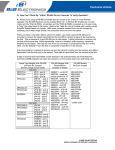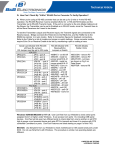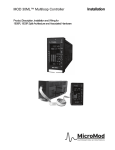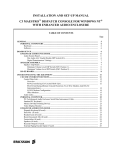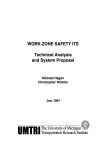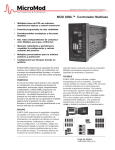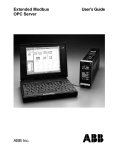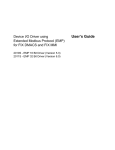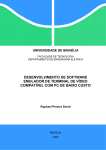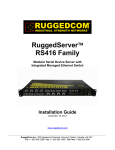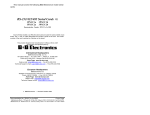Download Quatech DS-300 Hardware manual
Transcript
MODBUS™ RTU Communications Guide for use with MODCELL, MOD 30ML and Commander Products MODBUS RTU CONTENTS CONTENTS Page OVERVIEW ......................................................................................................................................................... 1 HARDWARE REQUIREMENTS.......................................................................................................................... 2 SERIAL INTERFACE CONSIDERATIONS .................................................................................................... 2 CABLE REQUIREMENTS .............................................................................................................................. 2 COMMUNICATIONS MODE........................................................................................................................... 2 RS-232 INTERFACE....................................................................................................................................... 3 RS-422 INTERFACE....................................................................................................................................... 3 RS-485 INTERFACE....................................................................................................................................... 3 BIAS RESISTORS .......................................................................................................................................... 3 TERMINATION RESISTORS ......................................................................................................................... 3 SOFTWARE BASICS .......................................................................................................................................... 5 MASTER/SLAVE RELATIONSHIP ................................................................................................................. 5 MESSAGE RESPONSE TIMES ..................................................................................................................... 5 INSTRUMENT RESPONSE TIMES TO HOST COMMANDS ........................................................................ 5 SOFTWARE DRIVERS................................................................................................................................... 6 MODBUS WITH MODCELL MLP AND MOD30ML............................................................................................. 7 STANDARD PROTOCOL ............................................................................................................................... 7 EXTENDED PROTOCOL ............................................................................................................................... 7 MOD 30ML COMMUNICATION CHANNELS................................................................................................. 7 USING ML AND CL BLOCKS:............................................................................................................................. 8 DIRECTING DATA WITH ML AND CL BLOCKS............................................................................................ 8 BLOCK CONNECTIONS ................................................................................................................................ 9 USING MODBUS MODULES:........................................................................................................................... 10 MODULE LOCATION ................................................................................................................................... 10 THE RS-485’S TERM (MASTER/SLAVE) SWITCH ..................................................................................... 10 THE COM DEFAULTS SWITCH .................................................................................................................. 10 THE HIGH AND LOW SWITCHES ............................................................................................................... 10 MODBUS MASTER ........................................................................................................................................... 12 MASTER REQUIREMENTS ......................................................................................................................... 12 DATA CONVERSION ................................................................................................................................... 12 SCALER BLOCK........................................................................................................................................... 12 INPUT CONVERT BLOCK ........................................................................................................................... 13 OUTPUT CONVERT BLOCK ....................................................................................................................... 13 MODBUS WITH COMMANDER SERIES INSTRUMENTS .............................................................................. 14 SCALING ANALOG VALUES ....................................................................................................................... 14 COMMUNICATIONS CONFIGURATION ..................................................................................................... 14 CONNECTION WITHIN THE NETWORK .................................................................................................... 14 HOST CONFIGURATION EXAMPLES ............................................................................................................. 15 MODBUS WITH FIX AND COMMANDER 150............................................................................................. 15 MODBUS WITH FIX AND COMMANDER 300............................................................................................. 16 MODBUS WITH INTOUCH AND COMMANDER 300 .................................................................................. 17 MODCELL MLP WITH TCP QUICKPANEL.................................................................................................. 18 PLC & Protocols ........................................................................................................................................ 18 Tags .......................................................................................................................................................... 18 Addressing ................................................................................................................................................ 18 Scaling....................................................................................................................................................... 19 MOD30ML AND MODCELL MLP REFERENCE TABLES ................................................................................ 20 WIRE CONNECTIONS...................................................................................................................................... 22 MODBUS MODULE TROUBLESHOOTING WITH MOD30ML AND MODCELL MLP ..................................... 23 GLOSSARY ....................................................................................................................................................... 25 i MODBUS RTU CONTENTS TABLES Page Table 1. Cable Requirements .............................................................................................................................2 Table 2. Instrument Response Times .................................................................................................................5 Table 3. Software Drivers....................................................................................................................................6 Table 4. MOD30ML and Modcell MLP Port Numbers.......................................................................................10 Table 5. Integer Conversion - Signed to Unsigned ...........................................................................................12 Table 6. MODBUS with FIX and Commander 150............................................................................................15 Table 7. MODBUS with FIX and Commander 300............................................................................................16 Table 8. MODBUS with InTouch and Commander 300 ....................................................................................17 Table 9. Wiring for RS-485 Full Duplex.............................................................................................................18 Table 10. TCP QuickPanel Addressing.............................................................................................................18 Table 11. MOD30ML and Modcell Multiloop Processor to Host Device or PC Sample Configuration Entries .20 Table 12. MODBUS Reference Information for MOD30 ML and Modcell Communications .............................21 Table 13. Wire Connections for RS-232 Devices..............................................................................................22 Table 14. Wire Connections for RS-485 (4 or 5-Wire) Devices ........................................................................22 Table 15. Wire Connections for RS-485 (2 or 3-Wire) Devices ........................................................................22 FIGURES Figure 1. Figure 2. Figure 3. Figure 4. ii Page RS-485 Biasing and Termination .........................................................................................................4 Extended and Standard MODBUS Lists ..............................................................................................8 Block Connections ...............................................................................................................................9 Module Switches................................................................................................................................11 MODBUS RTU COMUNICATIONS GUIDE OVERVIEW MODBUS RTU is a non-proprietary serial communications protocol that is widely used in the process control industry. The protocol was developed by Modicon for PLC communications and later released for public use. This protocol is available in all major Human Machine Interface (HMI) software packages and terminals. Many of the major controller and PLC manufacturers also offer MODBUS protocol as a standard or optional protocol in their instrumentation. The hardware over which MODBUS RTU communications are performed is not defined by the protocol. MODBUS RTU is supported on RS-232, RS-422, RS-485, Ethernet and other electrical standards. It should be noted that MODBUS RTU, MODBUS ASCII and MODBUS Plus are unique communication formats, and are not compatible with each other. This document will discuss MODBUS RTU only. 1 MODBUS RTU COMUNICATIONS GUIDE HARDWARE REQUIREMENTS SERIAL INTERFACE CONSIDERATIONS The Modbus protocol communicates with the instrumentation by means of an industry standard serial interface. This interface may be RS-232, RS-422 or RS-485. Some systems may also support the protocol over other busses or networks, such as Ethernet. An RS-232 interface allows only two devices to be connected together. RS-422 supports 1 driver and up to 10 receivers on a single network. For bi-directional communications, special tri-state circuitry is provided on the drivers of some instrumentation, allowing 10 driver/receiver pairs. RS-485 supports up to 32 driver/receiver pairs. With special hardware, the RS-422 and RS-485 limits can be expanded to allow as many as 248 devices on a single network. Each device on a network must have a unique address, which may be softconfigured or set with switches. Address zero is reserved for broadcast messages from the host to all slaves. All devices on a network must also be configured with the same parameters, such as baud rate and parity. In designing the communication architecture, one should consider communications performance when deciding how many devices to connect to a host port. Generally, nearly twice the performance can be achieved by splitting the devices from one port, onto two ports. CABLE REQUIREMENTS The type of wire to use is usually specified by the hardware manufacturer and will vary with required length. Wire with twisted pairs and an overall shield is used most often. The shield is tied to earth ground or chassis, and typically at one end only. The shield is not to be used as a signal common or ground. The table below lists typical cable recommendations. Table 1. Cable Requirements RS-232 Up to 15m (50ft) RS-422 and RS-485 Up to 6m (20ft) Up to 300m (1000ft) Up to 1200m (4000ft) virtually any standard shielded twisted pair with drain (Beldon 9502 or equivalent) virtually any standard shielded or twisted pair 24 AWG twisted pair with overall foil shield with drain wire (Beldon 9841 for 2-wire and 9502 for 4-wire or equiv.) 24 AWG twisted pair with foil shield and drain wire on each pair (Beldon 9841 for 2-wire and 9729 for 4-wire or equiv.) COMMUNICATIONS MODE Communications can take place in full or half-duplex mode. The communications hardware must be able to support whatever mode the software is using. Half-duplex hardware shares the same lines for transmit and receive, whereas, full-duplex hardware has dedicated transmit and receive lines. MODBUS protocol uses half-duplex communications, regardless of the hardware. Full-duplex hardware is more widely supported by software drivers and devices, than half-duplex. 2 MODBUS RTU COMUNICATIONS GUIDE RS-232 INTERFACE An RS-232 interface is rated for distances up to 15 meters (50 feet). At least three wires are required for an RS-232 interface. Wires are required for Transmit, Receive and Signal Ground. Some devices support additional wires for communication handshaking. RS-232 hardware is a full-duplex configuration, having separate Transmit and Receive lines. RS-422 INTERFACE An RS-422 interface requires at least four wires. Two wires each are used for Transmit and Receive. A fifth wire is usually required for Signal Ground, when connecting non-isolated devices together. Handshaking lines may also be supported by some hardware. This interface is full-duplex, allowing use of the same software drivers as for RS-232. The differential drivers allow for distances up to 1200 meters (4000 feet). The receivers of an RS-422 device are always enabled. For multi-drop operation, drivers must capable of tri-state operation. RS-485 INTERFACE An RS-485 interface requires at least two wires. In a two-wire configuration, the same pair of wires is used for Transmit and Receive. The two-wire configuration utilizes half-duplex communications. A four-wire configuration functions much like an RS-422 system, except the Transmit driver circuits are always taken offline or tri-stated, when not in use. This tri-state feature reduces the load on the network, allowing more devices, without the need of special hardware. A fifth wire is usually required for Signal Ground, when connecting non-isolated devices together. Additional wires for handshaking may also be supported by some hardware. This interface also uses differential drivers, supporting distances up to 1200 meters (4000 feet). BIAS RESISTORS RS-422 and RS-485 networks often require bias, or pull-up and pull-down resistors. These resistors are used to stabilize the network. By definition, in a MODBUS RTU network, it is the responsibility of the Master to provide this function. Functionally, any device on the network may provide the bias stabilization. Biasing may also be installed external to the devices, with the appropriate resistors and power supply. If the Master is not the device providing this function, careful consideration must be given to the consequences of that device failing. If the Master is providing this function, and it fails, there would be no communications anyway. In some systems, bias resistors may be installed on two slaves, offering redundant biasing. This feature is available with MOD30ML and Modcell MLP modules (TERM switch). Some systems may function without these stabilizing resistors, but may be more susceptible to communication errors. Though the pull-up and pulldown resistors are the same, the value of these resistors varies from device to device. The actual recommended resistance may be calculated, and varies with the number of devices on the bus. Commander series instruments use 1.8KΩ, while MOD30ML and Modcell use 560Ω. The pull-up resistor is connected from the positive communication line to +5Vdc. The pull-down resistor is connected from the negative communication line to the power supply common. TERMINATION RESISTORS Termination resistors are often used to reduce reflections on the network. This problem occurs most with long wires and high baud rates. Due to variations in wire and equipment, whether or not to use these terminators is usually determined by system testing. The general rule is to add them only if needed. The resistors are typically 120Ω, and installed across the Transmit and Receive wire pairs. Normally, one resistor is installed at each end of each pair of wires. For two-wire installations, one resistor would be installed at each end. If bias stabilization resistors are not installed, use of these terminations will probably drown the signal, preventing communications. 3 MODBUS RTU COMUNICATIONS GUIDE 2-Wire Configuration 4-Wire Configuration Figure 1. RS-485 Biasing and Termination 4 MODBUS RTU COMUNICATIONS GUIDE SOFTWARE BASICS MASTER/SLAVE RELATIONSHIP A MODBUS RTU system consists of a Master and one or more Slave devices. Multiple Masters are not permitted on the same network. The Master is responsible for initiating all communications, therefore, no peer-to-peer capability is supported. With some hardware, it is possible to dynamically switch the device between Master and Slave modes. This capability allows multiple Masters, though not simultaneously. With special hardware, such as Phoenix Digital’s MPE Plus, having multiple Masters is possible, though it limits the communications to the basic “Standard” MODBUS commands. Using the MPE Plus will block extended MODBUS communications, including the Application Builder. MESSAGE RESPONSE TIMES The MODBUS RTU protocol relies on precise timing for reliable communications. The message structure is such that a 3.5 character or greater pause will be interpreted as the end of a message. The actual time varies with the baud rate. Conversely, most devices require a defined minimum amount of time between messages. Another factor to consider is that each device has its own response time. This response time can be anywhere from a few milliseconds to a few hundred milliseconds. The Host must be configured to allow adequate time for the slowest device to respond. INSTRUMENT RESPONSE TIMES TO HOST COMMANDS These times represent the maximum time from when the instrument receives a request from the master, to when it begins to send the response. Table 2. Instrument Response Times Device C100 C150 C200 C300 C310 C500 * NOTE: Max Response Time 250 mSec 250 mSec 250 mSec 180 mSec 160 mSec 125 mSec Device C1900 Modcell MLP 2050R MOD30ML MR250 PR100 Max Response Time 250 mSec 60 mSec * 100 mSec 60 mSec * 125 mSec 90 mSec The response times for Modcell MLP and MOD30ML are for read messages. Write messages may take longer. These instruments have a configurable Write Message Timeout parameter. 5 MODBUS RTU COMUNICATIONS GUIDE SOFTWARE DRIVERS Table 3. Software Drivers 6 Driver 1719S 1733S 2010S 2011S I/O Server DDE Server OPC Server Description Standard MODBUS Driver Extended MODBUS Driver EMP 16-bit Standard and Extended MODBUS Driver EMP 32-bit Standard and Extended MODBUS Driver Standard MODBUS Standard MODBUS Standard and Extended MODBUS MODCELL MODBUS Enhanced Standard MODBUS Standard MODBUS Use With PC-30 and GFW PC-30 and GFW FIX 5.x for Windows 3.x FIX 6.x for Windows 95 and NT GFW Wonderware InTouch GFW32, FIX Dynamics and other OPC Clients Citect Citect and others MODBUS RTU COMUNICATIONS GUIDE MODBUS WITH MODCELL MLP AND MOD30ML STANDARD PROTOCOL “Standard” MODBUS supports single-register, 16-bit integer values. Modcell and MOD30ML floating-point data may be converted to this format with ML blocks. For maximum resolution, specify an actual engineeringunit range in the ML block. If the engineering range is greater than 65535, a scaled range must be selected. Some standard MODBUS drivers may be capable of reading floating-point data, using a 32-bit two-register format. The standard MODBUS driver (MB1) for Fix DMACS does not support the floating point format from Modcell MLP and MOD30ML. The standard MODBUS driver for PC-30 and GFW supports Modcell MLP and MOD30ML floating point signals. A MODBUS I/O Server is also available for GFW, supporting floating-point. EXTENDED PROTOCOL Modcell and MOD30ML devices support an extended protocol, in addition to standard MODBUS RTU as a subset. If the Master is capable of utilizing the extended features, additional data types, diagnostics and event information may be obtained. The extended protocol also supports the Status Page in the Application Builder and very fast uploads and downloads. Note that the 2-wire RS-485 module does not support these features. The Extended MODBUS protocol implemented in Modcell and MOD30ML utilizes a user-defined MODBUS command, and custom drivers are required in the host to support it. Custom drivers supporting this Extended MODBUS protocol are available for PC-30, Genesis for Windows and FIX DMACS. The PC-30/GFW driver supports only Extended MODBUS. The FIX drivers also support standard MODBUS devices, even on the same network as Extended MODBUS devices. When using Extended MODBUS, special interface files are created when compiling the instrument database. These files provide automatic configuration of host poll records, significantly reducing engineering time. A MIF file is used for FIX software. PC-30 and GFW use a TIF file. With Extended MODBUS, user-friendly alias names are given to points in the Configured List. In the host software, these alias names are used instead of register addresses. MOD 30ML COMMUNICATION CHANNELS The built-in communication channel on a MOD30ML can be used with front or rear connection, but not simultaneously. The front connection is RS-232 only, and the rear connection can be either RS-232 or RS485. Connecting wires to the rear terminations may prevent communications through the front port, even if the rear terminations are not being used. Installing a communication module in slots S9-10 or S10 will disable the built-in channel. A second communication channel can be added by installing a module in slots S7-8 or S8. 7 MODBUS RTU COMUNICATIONS GUIDE USING ML AND CL BLOCKS: DIRECTING DATA WITH ML AND CL BLOCKS CL blocks can be connected to MSC blocks, and are usually used for discrete points. A CL block is required for multi-register “standard” MODBUS functions, such as those needed for floating point signals. If a floating point value is placed into an ML block, it is converted to a 16-bit integer value to be sent to the host. If floating point values are placed into a CL, they can be connected to a multi-register input of the MSC block using two registers, or 32 bits. The data format is per ANSI / IEEE Std 754-1985 for Binary Floating-Point Arithmetic. This is the format used by Motorola. * NOTE: Solid connection lines represent the most commonly used connections. Figure 2. Extended and Standard MODBUS Lists 8 MODBUS RTU COMUNICATIONS GUIDE BLOCK CONNECTIONS (Up to 99 Inputs per Block) Figure 3. Block Connections 9 MODBUS RTU COMUNICATIONS GUIDE USING MODBUS MODULES: MODULE LOCATION The sockets in which the module is installed determines its Port number Table 4. MOD30ML and Modcell MLP Port Numbers Port Number 1 2 3 MOD30ML Built-In, Slots 9-10 or 10 Slots 7-8 or 8 not available Modcell MLP Slots 31-32 or 32 Slots 29, 28-28, 30 or 29-30 Slots 25-26, 26, 26-27, 27, 27-28 or 28 THE RS-485’S TERM (MASTER/SLAVE) SWITCH • The master is responsible for stabilizing the bus • In the YES position the module provides this master function by pulling the comm+ line high and the comm- line low, each through 560Ω resistors • Some PC cards have these resistors built in, generally only on the receiver. This works fine in 4wire mode if the transmitter does not tri-state, or in 2-wire mode. 4- wire mode, with a tri-stating transceiver, may require a module to have its switch in the master position, even if its not acting as the master. THE COM DEFAULTS SWITCH • If the MOD30 ML or Modcell MLP configuration is unknown, setting this switch to th eYES position will allow communications with the unit at 9600 baud, no parity, 8 data bits and 1 stop bit. After downloading the desired parameters, remove power, COM DEFAULTS switch to NO and power up. THE HIGH AND LOW SWITCHES • Set the MODBUS Address • The High switch sets the first hexadecimal digit of the address, and the Low switch sets the second. For example, a switch setting of 13 hex represents a decimal address of 19. The 2-wire RS-485 module has no switches. It must be configured by the Application Builder software, to change the factory defaults. The factory defaults are 9600 baud, no parity, 8 data bits, one stop bit and a MODBUS address of one. Do not connect an unconfigured module to a network if there is another device on the network with address one. 10 MODBUS RTU COMUNICATIONS GUIDE COMM RS232 CAT. NO. 2033NZ10000A YES COMM DEFAULTS NO COMM RS485 T E R M * NOTE: CAT. NO. 2034NZ10000A YES NO HIGH LOW YES COMM DEFAULTS HIGH LOW NO Address is indicated with the flat side of the switch Figure 4. Module Switches 11 MODBUS RTU COMUNICATIONS GUIDE MODBUS MASTER MASTER REQUIREMENTS MODBUS Master communication requires a few special configuration items. 1. MSC Block - Each MSC block that will be used for MODBUS Master communications must have the Port Functionality set to Master. 2. EX Block for Port Configuration - Each MODBUS Master port requires a specially configured Expression block to define its parameters. 3. EX Block for Communications - Expression blocks are configured to send and receive the actual communication messages. The first 10 inputs are dedicated to configuration and status. The remaining inputs may be used to read or write data. Each block is configured to execute a specific type of MODBUS function. The only relevant factor that limits the number of these blocks is performance. DATA CONVERSION Analog data in a newer Commander instruments and the 2050R is stored as a 16-bit signed integer value. Integer values in the Modcell MLP and MOD30ML are unsigned. The decimal point position is also read as a separate value. When reading or writing analog values between these instruments, expression blocks are used to convert from one integer type to the other. The table below indicates the relationship between the two number formats. Table 5. Integer Conversion - Signed to Unsigned Signed 16-Bit Number 0 32767 -32768 -1 Unsigned 16-Bit Number 0 32767 32768 65535 SCALER BLOCK One expression block is required for each slave instrument, for decimal point scaling. The expression is as follows: if DecPt == 0 then 1.0 else if DecPt == 1 then 10.0 else if DecPt == 2 then 100.0 else 1000.0 DecPt is a COUNT input which is read from the slave instrument. The block’s Result is a FLOATING-POINT scaler. 12 MODBUS RTU COMUNICATIONS GUIDE INPUT CONVERT BLOCK One expression block is required for each analog value read from the slave instrument, for data type conversion. The expression is as follows: if Input > 32767 then (Input - 65536.0) / Scaler else Input / Scaler Input is a COUNT value which is read from the slave instrument. Scaler is the FLOATING-POINT result of the Scaler block. OUTPUT CONVERT BLOCK One expression block is required for each analog value written to the slave instrument, for data type conversion. The expression is as follows: if (Output * Scaler) > 32767.0 then 32767 else if (Output * Scaler) < -32768.0 then 32768 else if Output >= 0 then Output * Scaler else 65536.0 + (Output * Scaler) Output is the FLOATING-POINT number to be converted to a COUNT, and send to the slave instrument. Scaler is the FLOATING-POINT result of the Scaler block. 13 MODBUS RTU COMUNICATIONS GUIDE MODBUS WITH COMMANDER SERIES INSTRUMENTS SCALING ANALOG VALUES The first Commander instruments to support MODBUS handled scaling of analog values in a different way than later instruments. The C200, C300, C1900 and PR100 use a 12-bit register with a raw range of 0 to 4095. The host must scale the value to obtain the desired engineering unit value. Newer models, such as the C100, C150, C250, C500 and PR250, place an engineering unit value into one or two 16-bit registers. If two registers are used, the data type is considered a long integer. Values are represented as positive or negative integers without a decimal point. If a decimal point is used in the instrument, additional scaling must be performed at the host. COMMUNICATIONS CONFIGURATION The Commander must be configured from the face of the instrument via the Serial Data Communications page. If this page is not accessible, the communications option may not be installed. Some Commanders use a security switch to access the configuration mode. The parameters on this menu group must be set to match host or Modbus Master device. The 3 Line type refers to 2-wire (half-duplex) with a common, where 5 Line is 4-wire (full-duplex) with a common. The number of Start and Data bits are fixed at 1, 8 respectively. The number of Stop Bits is not configurable and can be set to 1 or 2 at the host. Parity can be set to none, odd or even and must match the Host setting. The Ident or Addr entry configures the Modbus Slave address. CONNECTION WITHIN THE NETWORK One additional subject that must be addressed, is the electrical stabilization and electrical connection of the RS-485 network. By definition, the Modbus Master device is to supply the pull-up and pull-down resistors to stabilize the network. If the interface device does not have that capability, you may select the "Linked In" jumper setting on the Commander. If the stabilizing is performed at the Commander, and the Commander fails or is removed from the network, all communications may be stopped. Depending on the length of your cable, you may also need termination resistors, which may be installed externally for 3-wire or by a jumper for 5-wire configurations. 14 MODBUS RTU COMUNICATIONS GUIDE HOST CONFIGURATION EXAMPLES MODBUS WITH FIX AND COMMANDER 150 Either the MB1 or EMP driver may be used, though EMP is recommended. The MODBUS guide uses 1 and 2-digit numbers for addresses. Note that the actual addressing requires a 5-digit number. For digital addresses, use 000xx format, where xx represents the coil address from the instruction book. For analog addresses, use 400xx format, where xx represents the register address from the instruction book. Table 6. MODBUS with FIX and Commander 150 Poll Record Configuration Hardware MODBUS Addressing Type 5-Digit Bit Base 0-15 Data Types Unsigned - Positive Analog Ranges (up to 9999) Signed - Analog Ranges (between -999 and +9999) Long - Analog Double Register Values (between -9999 and 99999) Database Configuration Data Type Database Block Address Range Notes Digital Input DI 000xx Digital Output DO 000xx Digital I/O DR 000xx select output enable Analog Input AI 400xx LIN Signal Conditioning Analog Output AO 400xx LIN Signal Conditioning Analog I/O AR 400xx LIN Signal Conditioning NOTES: 1. Each line of the poll record can have no more than 8 analog or 16 digital addresses. 2. It is acceptable to “read through” undefined addresses. 3. Use a calculation block to scale for proper decimal point position. 15 MODBUS RTU COMUNICATIONS GUIDE MODBUS WITH FIX AND COMMANDER 300 Either the MB1 or EMP driver may be used, though EMP is recommended. The MODBUS guide uses 3-digit numbers for addresses. Note that the actual addressing requires a 5-digit number. For digital addresses, use 00xxx format, where xxx represents the coil address from the instruction book. For analog addresses, use 40xxx format, where xxx represents the register address from the instruction book. Table 7. MODBUS with FIX and Commander 300 Poll Record Configuration Hardware MODBUS Addressing Type 5-Digit Bit Base 0-15 Data Type Unsigned - Positive Analog Ranges (0 to 4095) Signed - Analog Ranges that go Negative (-2048 to +2047) Database Configuration Data Type Database Block Address Range Notes Digital Input DI 00xxx Digital Output DO 00xxx Digital I/O DR 00xxx select output enable Analog Input AI 40xxx 12BN (positive) or LZ12 (live zero) Signal Conditioning Analog Output AO 40xxx 12BN (positive) or LZ12 (live zero) Signal Conditioning Analog I/O AR 40xxx 12BN (positive) or LZ12 (live zero) Signal Conditioning NOTES: 1. Ensure that each line of the poll record contains no more than 8 analogs or 16 digital addresses. 2. It is acceptable to “read through” undefined addresses. 16 MODBUS RTU COMUNICATIONS GUIDE MODBUS WITH INTOUCH AND COMMANDER 300 Below are configuration entries that have been tested with the InTouch Modbus DDE Server and C300. Table 8. MODBUS with InTouch and Commander 300 Hardware String Variable Style Register Type Block I/O Sizes Coil Read - 16 Coil Write* - 8 * NOTE: 584/984 PLC Full Length Binary Register Read - 8 Register Write - 8 The Commander supports only Single-Coil writes (Function Code 05), so Block I/O does not apply. InTouch allows a minimum setting of 8. In the InTouch Display Configuration Window; 1. Select the desired Value Display Wizard to place a display field into the window 2. Double-click on the display field to configure it 3. Assign a Tagname 4. Check the Allow Input box if you wish to write values from the PC to the Commander 5. Define the Tagname 6. Select DDE Real for analog values 7. Set the Min and Max EU values to match the Commander Display Range 8. Set the Min and Max Raw values to the Response/Entry range specified in the Modbus guide 9. Select DDE Access Name as defined in the I/O Server 10. Specify the Item as a 5-digit Modbus address (i.e. 40051 for Process Variable 1) 11. Coil addresses in the Commander range from 00011 to 00181 12. Register addresses in the Commander range from 40011 to 40230 17 MODBUS RTU COMUNICATIONS GUIDE MODCELL MLP WITH TCP QUICKPANEL Table 9. Wiring for RS-485 Full Duplex QuickPanel jr. TXA 11 TXB 15 RXA 10 RXB 16 Frame Ground 1 RTS 4 CTS 5 CTSB 18 DTRB 19 CTSA 21 DTRA 22 ————— ————— ————— ————— — Shield —— —— —— —— —— —— Modcell MLP 29-1 Rx+ 29-2 Rx30-1 Tx+ 30-2 Tx- PLC & Protocols SIO/CN1 PLC Modicon Modbus is used when QuickPanel is Master to MLP Modicon Modbus Slave is used when QuickPanel is slave to MLP Port Electrical Format: RS-422/485 Full duplex Baud rate, Data bits, Parity and Stop Bits to match the MLP configuration Handshake: None Protocol PLC ID: Modbus address of the MLP Tags Analog points are read from the MLP as an integer value (16-bit). MLP floating-point numbers are not supported by this interface. Addressing Registers are referenced as a type and offset. Below are examples for Input Registers and Output (Holding) Registers. Table 10. TCP QuickPanel Addressing ML to MSC SROIN1 Entry 1 Entry 2 ML to MSC SRWIN1 Entry 1 Entry 2 Modbus Address 30001 30002 QuickPanel Tag IR001 IR002 40001 40002 OR001 OR002 If connecting more than one slave to the QuickPanel, append an underscore and Modbus address to the tag. Example: QuickPanel is configured to access PLC ID 1 For MLP at address 2, with the same registers as above, the tags would be IR001_2, IR002_2, OR001_2 and OR002_2. 18 MODBUS RTU COMUNICATIONS GUIDE Scaling In ML Block, specify actual range for variable, if the number of significant digits is 5 or less. For ranges with more than 7 significant digits, such as 500,000 or 750.000, change the units to allow smaller numbers. For example, instead of 0 to 500,000 CFH, use 0 to 500 KCFH. Also note that the scale factor is for use only with mSec time values. The field is enabled for sources that can support the data type. If your source data is not mSec time, do not change the scale factor from default. In QuickDesigner, leave Input Low at 0 and High at 65535. The Scale Low and High values should match what is in the Modbus List, unless a decimal is required. If digits to the right of the decimal are needed, multiply the range value by 10 for one place, 100 for two and etc.. For example, if two places are desired to the right of the decimal point with a range of 0 to 10, specify a Scale High of 1000. In display Data Format, specify 2 decimal places. 19 MODBUS RTU COMMUNICATIONS GUIDE MOD30ML AND MODCELL MLP REFERENCE TABLES Table 11. MOD30ML and Modcell Multiloop Processor to Host Device or PC Sample Configuration Entries MOD30ML or Modcell Multiloop Processor Signal Source List Engineering Modbus List Data Range Type Entry Range Scale MSC Modbus Type Low High CL ML Number Low High Factor Connection Address Floating 0 100 X 1 0 100 SRWIN1 40001 Point Floating -10 10 X 2 -10 10 SRWIN1 40002 Point Floating -14 0 X 3 -14 0 SRWIN1 40003 Point Floating 0 80000 X 1 0 8000 SRWIN2 40101 Point mSec 0 4294967295 X 2 0 65535 1 SRWIN2 40102 Time mSec 0 4294967295 X 3 0 65535 10 SRWIN2 40103 Time mSec 0 4294967295 X 4 0 65535 100 SRWIN2 40104 Time mSec Time mSec Time mSec Time Discrete Discrete Device Engineering Data Range Range Type Low High Low High WORD 0 65535 0 100 WORD 0 65535 -10 10 WORD 0 65535 -14 0 WORD 0 65535 0 8000 WORD 0 65535 0 65535 WORD 0 65535 0 65535 WORD 0 65535 0 65535 0 4294967295 X 5 0 65535 1000 SRWIN2 40105 WORD 0 65535 0 65535 0 4294967295 X 6 0 65535 10000 SRWIN2 40106 WORD 0 65535 0 65535 0 4294967295 X 7 0 65535 100000 SRWIN2 40107 WORD 0 65535 0 65535 0 1 X 8 SRWIN2 40108 WORD 0 65535 0 1 0 1 X 9 SRWIN2 40109 WORD 0 65535 0 1 Discrete 0 Discrete 0 Floating 0 Point Floating -10 Point Floating -14 Point Floating 0 Point 1 1 100 X X X 1 2 1 DRWIN1 DRWIN1 MRWIN1 00001 00002 41001 BIT BIT FLOAT 0 0 0 1 1 100 0 0 0 1 1 100 10 X 2 MRWIN1 41003 FLOAT -10 10 -10 10 0 X 3 MRWIN1 41005 FLOAT -14 0 -14 0 80000 X 1 MRWIN2 41101 FLOAT 0 80000 0 80000 * NOTE: 20 Host Device or PC Note 10x mult req’d 1 mSec / count 10 mSec / count 100 mSec / count 1 Sec / count 10 Sec / count 100 Sec / count Bit 1 of 16 Bit 1 of 16 Bit 1 of 1 Bit 1 of 1 When connections are made from a source that has a variable data type, the Range and Scale Factor fields may be enabled when they do not apply. In this case, leave the default Range of 0 to 65535 and Scale Factor of 1. MODBUS RTU COMMUNICATIONS GUIDE Table 12. MODBUS Reference Information for MOD30 ML and Modcell Communications Code 01 02 03 04 05 06 08 15 16 65 Function Action Read Coil Status Read one or more consecutive points Read Input Status Read one or more consecutive points Read Holding Read one or more Registers consecutive registers Read Input Registers Force Single Coil Preset Single Register Loopback Test Force Multiple Coils Preset Multiple Registers Read one or more consecutive registers Write one point Write one register Return of Query (00) Write one or more consecutive points Write one or more consecutive registers Extended Modbus Read and/or Write any Data Type Data Types Discrete Max Points per Address From To Command Range 99 00001-00499 CL DRWIN1-5 Discrete 99 10001-10499 CL DROIN1-5 All except ASCII and HEX One Register per Point Any - Uses as many Registers as req'd for Data All except ASCII and HEX One Register per Point Any - Uses as many Registers as req'd for Data Discrete All except ASCII and HEX One Register per Point Any - Uses as many Registers as req'd for Data For Diagnostic Use Only Discrete 32 40001-40499 ML SRWIN1-5 125 41001-45999 CL MRWIN1-5 32 30001-30499 ML SROIN1-5 125 31001-35999 CL MROIN1-5 1 1 00001-00499 40001-40499 CL ML DRWIN1-5 SRWIN1-5 1 41001-45999 CL MRWIN1-5 N/A 16 N/A N/A 00001-00499 CL N/A DRWIN1-5 16 40001-40499 ML SRWIN1-5 16 41001-45999 CL MRWIN1-5 Note 6 n/a CL FGLISTIN All except ASCII and HEX One Register per Point Any - Uses as many Registers as req'd for Data Any - Data in buffer, rather than Coils or Registers NOTES: 1. Placing discrete points into Holding or Input Registers uses an entire 16 bit register for one point. This may be more efficient when only a small amount of discrete data is required, along with analog data. If a significant number of discrete points are required, communications and memory efficiency would be improved by placing them into the Coil or Input Status area. Another possibility would be to pack 16 discrete points into a count and store it in an Input or Holding Register. This would be dependent on the host device's ability to accept the packed data format. 2. Date, Floating Point and mSec Time are converted to 16 bit integers when tied to an ML register. 3. It is recommended that no more than the number of points supported per command be put into each Slave ML block. This will prevent the Master device from accessing more than the allowed number of points in a single command. The instrument will not return any data if the maximum number of registers is exceeded or an invalid register is included. Some HMI packages, such as Fix DMACS, allow poll records to be broken into groups to avoid this problem. 4. When using Extended Modbus, group control loop data together in CL blocks for greatest efficiency. 5. Some peripheral equipment that is designed for Modbus communications may not support Extended Modbus (function code 65). 6. The instrument's foreground can hold up to 2400 bytes of data. The number of points that can be handled per command depends on the host software. Connecting the CL block to BGLISTIN may provide increased performance with some host configurations. This is the case when using Database Caching with PC-30 or Genesis for Windows. Without Database Caching enabled, a connection to FGLISTIN is recommended. 7. Each Modbus List block can contain up to 99 points, and each type of connection provides inputs for five lists. This is also true for Configured List blocks for Standard Modbus. When using Extended Modbus, Configured List blocks may be nested, allowing more than 99 points to be connected to FGLISTIN or BGLISTIN. 21 MODBUS RTU COMMUNICATIONS GUIDE WIRE CONNECTIONS Table 13. Wire Connections for RS-232 Devices PC Serial Port 25-Pin 9-Pin 2 3 7 3 2 5 MOD30ML Port 1 Port 2 BI 9&10 7&8 3 9 13 2 8 12 1 10 14 Mod cell MLP Hi-1 Hi-2 Lo-2 RS-232 Master ⇒ Tx ⇐ Rx Gnd ⇔ Slave Rx Tx Gnd MOD30ML Port 1 Port 2 BI 9&10 7&8 2 8 12 3 9 13 1 10 14 Modcell MLP Hi-2 Hi-1 Lo-2 Table 14. Wire Connections for RS-485 (4 or 5-Wire) Devices B&B Quatech OPTO-22 3PXOCC2A DSP-225 AC 24 AT 3PXCC2A DS-300 or AC 34 2 2 4 3 7 5 9 4 8 1 8 9 5 3 3 B&B MOD30ML Port 1 Port 2 BI 9&10 7&8 3 9 13 2 8 12 5 11 15 4 10 14 1 Mod RS-485 cell (4 or 5-Wire) MLP Master Slave Hi-1 Tx+ ⇒ Rx+ ⇒ Hi-2 TxRxLo-1 Rx+ ⇐ Tx+ ⇐ Lo-2 RxTxGnd ⇔ Gnd MOD30ML Modcell Port 1 Port 2 BI 9&10 7&8 MLP 2050R 5 11 15 Lo-1 35 4 10 14 Lo-2 34 3 9 13 Hi-1 33 2 8 12 Hi-2 32 1 29 Quatech OPTO-22 RS-485 Commander C100 (4 or 5-Wire) 3PXCC2A DS-300 or AC 34 Master Slave MR250 C1900 C150 C200 C300 2 2 4 Tx+ ⇒ Rx+ 7 7 22 7 9 ⇒ 3 7 5 TxRx8 6 23 6 10 9 4 8 Rx+ ⇐ Tx+ 3 4 20 4 11 ⇐ 1 8 9 RxTx2 5 21 5 12 5 3 3 Gnd ⇔ Gnd 12 8 24 Gnd 8 3PXOCC2A DSP-225 AC 24 AT C310 21 22 18 19 20 C500 PR100 34 3 35 2 32 5 33 6 36 8 Table 15. Wire Connections for RS-485 (2 or 3-Wire) Devices B&B Quatech OPTO-22 MOD30ML Mod RS-485 MOD30ML Modcell Port 1 Port 2 cell Port 1 Port 2 (2 or 3-Wire) 3PXCC2A DS-300 or AC 34 BI 9&10 7&8 MLP Master Slave BI 9&10 7&8 MLP 2050R 2&9 2&4 4-8 3&5 9&11 13&15 Hi&Lo-1 RxTx+ ⇔ RxTx+ 3&5 9 13 -1 33&35 3&1 7&8 5-9 2&4 8&10 12&14 Hi&Lo-2 RxTx- ⇔ RxTx- 2&4 8 12 -2 32&34 5 3 3 1 Gnd ⇔ Gnd 1 29 3PXOCC2A DSP-225 AC 24 AT B&B Quatech OPTO-22 RS-485 Commander C100 (2 or 3-Wire) 3PXCC2A DS-300 or AC 34 Master Slave MR250 C1900 C150 C200 C300 C310 C500 PR100 2&9 2&4 4-8 RxTx+ ⇔ RxTx+ 3&7 4 22 4 34 3&1 7&8 5-9 RxTx- ⇔ RxTx- 2&8 5 23 5 35 5 3 3 Gnd ⇔ Gnd 12 8 24 7 36 3PXOCC2A DSP-225 AC 24 AT * NOTES: 1. MOD30ML and Modcell do not support MODBUS Master communications with a 2-wire RS-485 module. 2. On Modcell MLP and MOD30ML, 4-wire modules are recommended for all applications, even for 2-wire installations. ∆ WARNING Incorrect wiring can damage communication hardware. 22 MODBUS RTU COMMUNICATIONS GUIDE MODBUS MODULE TROUBLESHOOTING WITH MOD30ML AND MODCELL MLP * NOTE: The extended Modbus communications required for diagnostics and downloading is supported by the 2033N and 2034N modules only. On Modcell, the Identity module firmware must be at least version 4 Logic, version 3 Regulatory, Batch, or Advanced. 1. Remove power from the instrument. 2. Note the switch settings on the Modbus module. Two rotary switches are used to select the address. The address is indicated in hexadecimal, by the flat side of the spindle, with A through F representing 10 through 15. 3. Set the COMM DEFAULTS switch to YES. This will force the module to communicate at 9600 baud, 8 data bits, 1 stop bit and no parity, regardless of the database configuration. Note that these default parameters will be in effect whenever the default database is being executed. 4. If using an RS-485 module, set the TERM switch to NO. This switch provides pull-up and pull-down resistors to stabilize the network. This function is defined by the Modbus specification as the responsibility of the master node, which is the PC in this case. In some cases, it may be necessary to enable this termination, if the PC interface is unable to stabilize the network. 5. Apply power to the equipment. 6. Start the Application Builder software and select the serial port configuration button. Select the serial port that is connected to the instrument and confirm the port settings. The standard Base Addresses are 3F8, 2F8, 3E8 and 2E8 for Com1 through Com4 respectively. If unsure of the address, check the hardware manual for configuration information. Set the Baud Rate to 9600, Data Bits to 8, Parity to None and Stop Bits to 1. 7. Enter the Status display and select the communications setup button. Set the communications type to Extended Modbus. Set the Modbus Address to match the module setting and select the com port to be used. Select OK to close the dialog box. The ICN and Instrument number settings have no effect. 8. Click on the Status line at the bottom of the screen and enter R VERSION. This command will return the version of the instrument. If the instrument responds, confirm that the reported version agrees with the type of instrument that is being tested. 9. If unable to establish communications, disconnect power and remove all analog and communications modules, except for the Modbus module being used. If still unable to communicate, replace the Modbus module. If all previous procedures fail, replace the instrument. 23 MODBUS RTU COMMUNICATIONS GUIDE 24 MODBUS RTU COMMUNICATIONS GUIDE GLOSSARY The following terms are defined as they relate to this document. The definitions given here may not be the same throughout the industry. Alias A meaningful short-hand name given to a data point Baud Serial communication data transmission rate Bit A binary digit, representing a one or zero Bus An electrical circuit over which data is transmitted Byte A whole number value represented by eight bits (0 to 255) CL block Configured List block Chassis or Chassis Ground A connection to an electrically conductive housing or frame of a device. It may or may not be connected to Earth Ground. Common The voltage reference point of a circuit. It may or may not be connected to earth ground, though it is generally assumed to be at zero volts, unless otherwise indicated. In floating circuits, the common is sometimes at a relatively high potential. This term is sometimes used interchangeably with the term “Ground”. CRC Cyclic Redundancy Check. Complex error checking on a message block. CTS ClearToSend hardware handshaking signal. Used with RequestToSend. Earth or Earth Ground Global zero voltage reference point. Physical connection is made to the earth through a grounding rod, water pipe or other reliable connection. Ground Voltage reference point of a circuit. It may or may not be connected to earth ground, though it is generally assumed to be at zero volts. Sometimes used interchangeably with the term “Common”. Handshaking A method of data flow control for serial communications Hexadecimal or HEX A number system using a decimal 16 as its base. A single digit number in HEX ranges from 0 to 15, represented by 0 to 9 and A to F. HMI Human-Machine Interface (formerly MMI) Live Zero Indicates that a numeric range contains both positive and negative numbers Loopback A test used for checking functionality of a serial port, utilizing a test plug that connects send, receive and handshaking signals Long Integer Analog value consisting of two consecutive 16-bit registers ML block MODBUS List block MLP MultiLoop Processor (Modcell 2000 Series Controller) MSC block MODBUS Serial Communications block Parity Simple method of data error checking performed at the byte level. May be user-specified as Odd, Even or None with most equipment and software. 25 MODBUS RTU COMMUNICATIONS GUIDE PC Personal Computer Receive Incoming communication signal. (Rx) RTS RequestToSend hardware handshaking signal. Used with ClearToSend. Rx See Receive RxA Usually the negative Receive line. May vary with manufacturer. Also see Receive RxB Usually the positive Receive line. May vary with manufacturer. Also see Receive Signed Integer Whole number value represented by 16 bits (-32768 to 32767) Transmit Outgoing communication signal. (Tx) Tri-State The ability of a communications transmitter to turn its circuitry off, reducing the load on the network Tx see Transmit TxA Usually the negative Transmit line. May vary with manufacturer. Also see Transmit TxB Usually the positive Transmit line. May vary with manufacturer. Also see Transmit Unsigned Integer Positive whole number value represented by 16 bits (0 to 65535) Word A group of 16 bits Xon/Xoff Software implementation of data flow control 26 The Company’s policy is one of continuous product improvement and the right is reserved to modify the information contained herein without notice, or to make engineering refinements that may not be reflected in this bulletin. Micromod Automation assumes no responsibility for errors that may appear in this manual. © 2004 MicroMod Automation, Inc. Printed in USA IB-MODBUS-RTU, Issue 2 MicroMod Automation, Inc. 75 Town Center Drive Rochester, NY USA 14623 Tel. 585-321-9200 Fax 585-321-9291 www.micromodautomation.com 04/2005
































